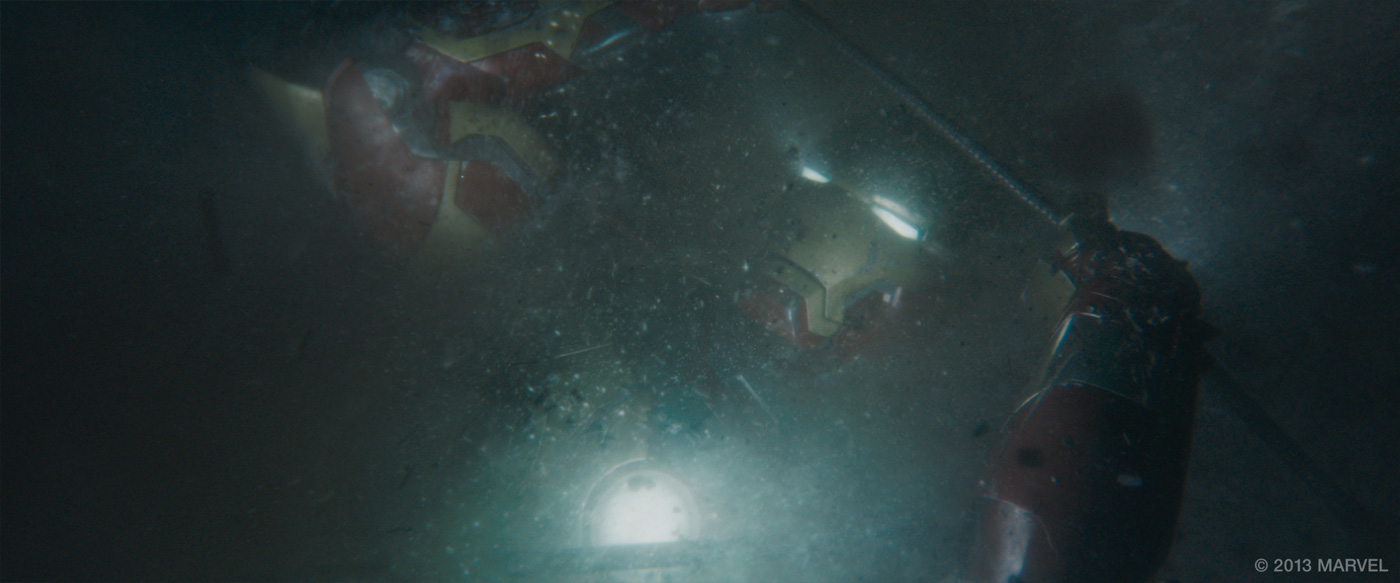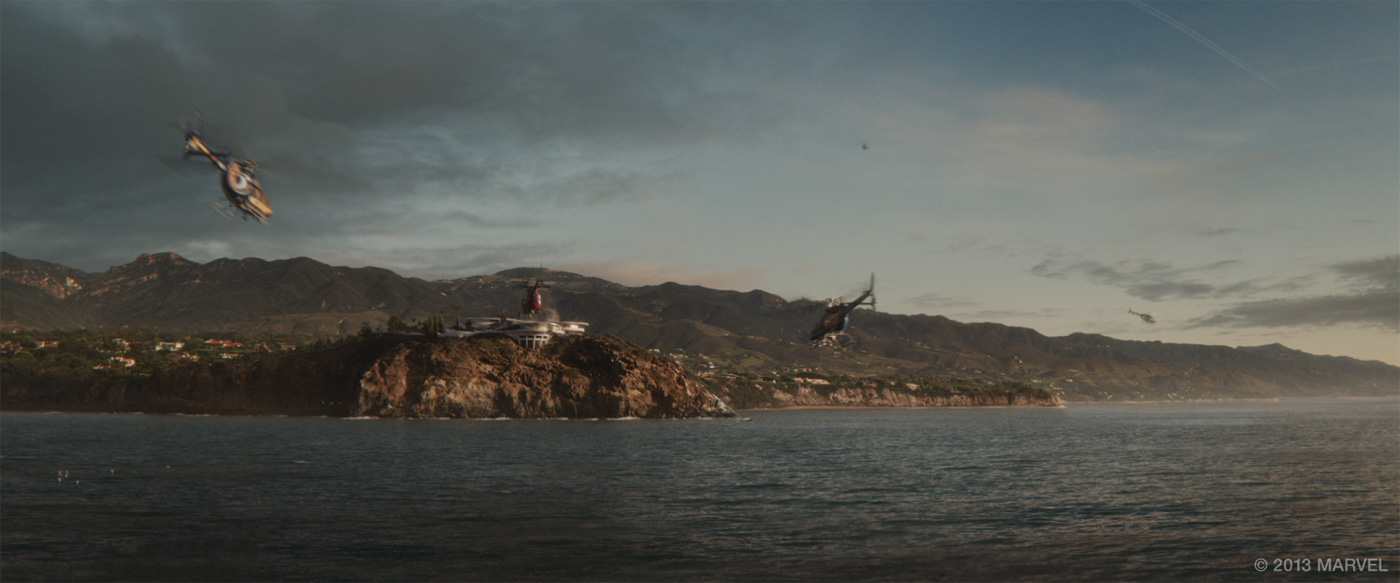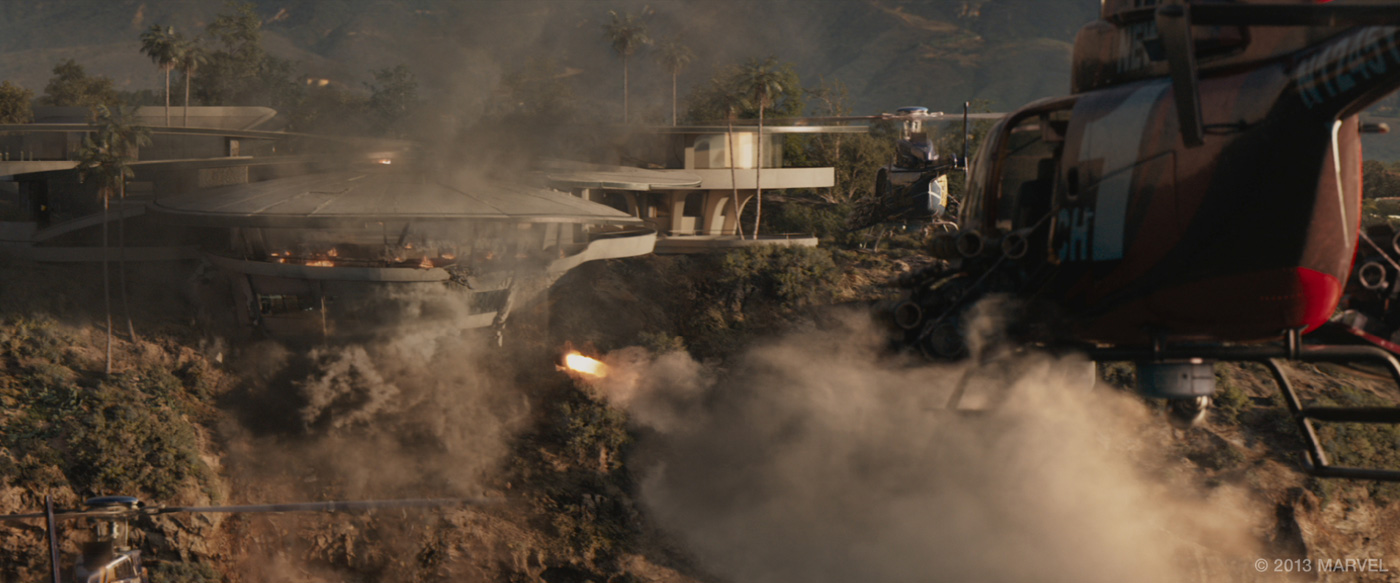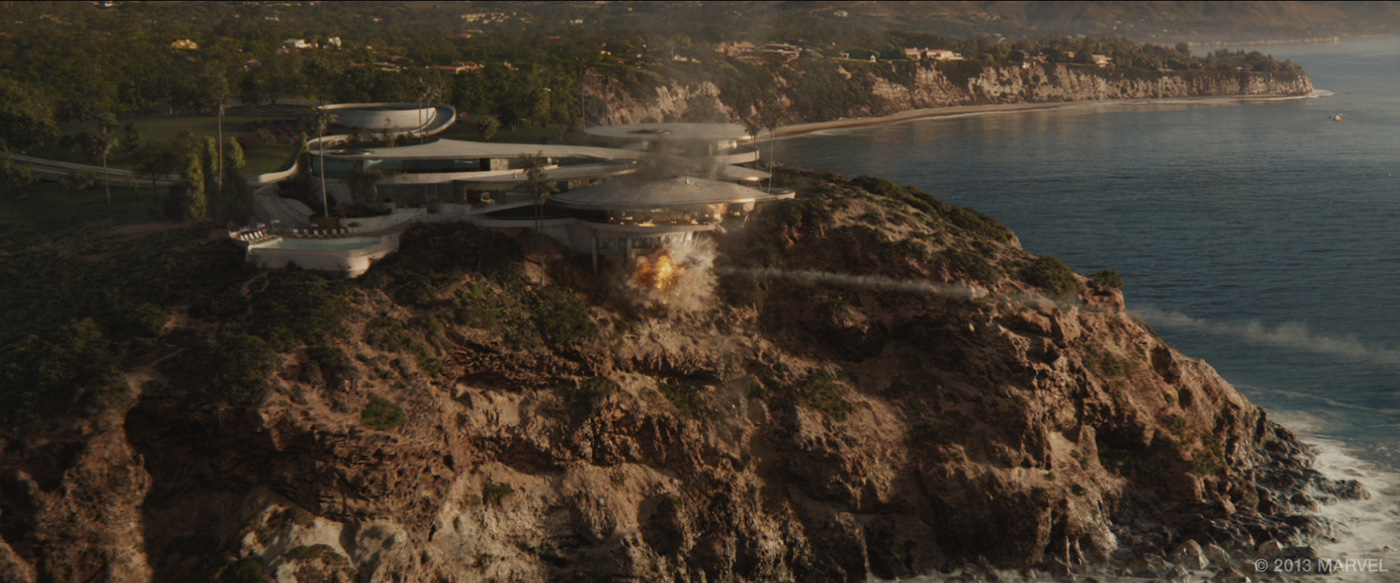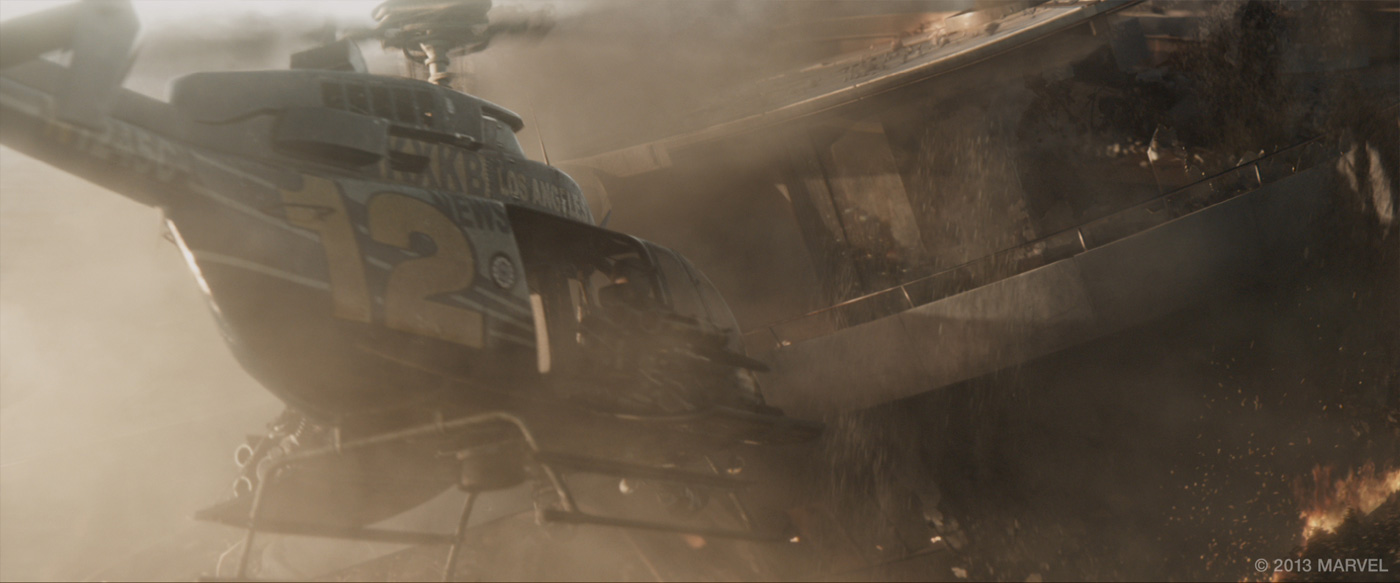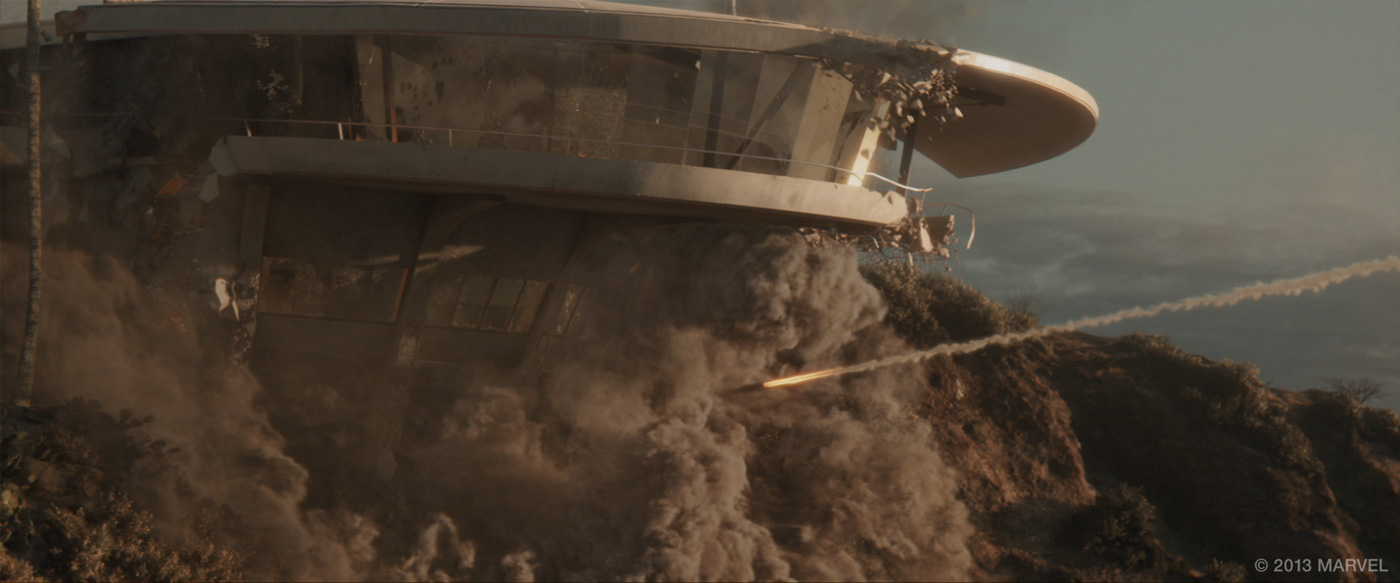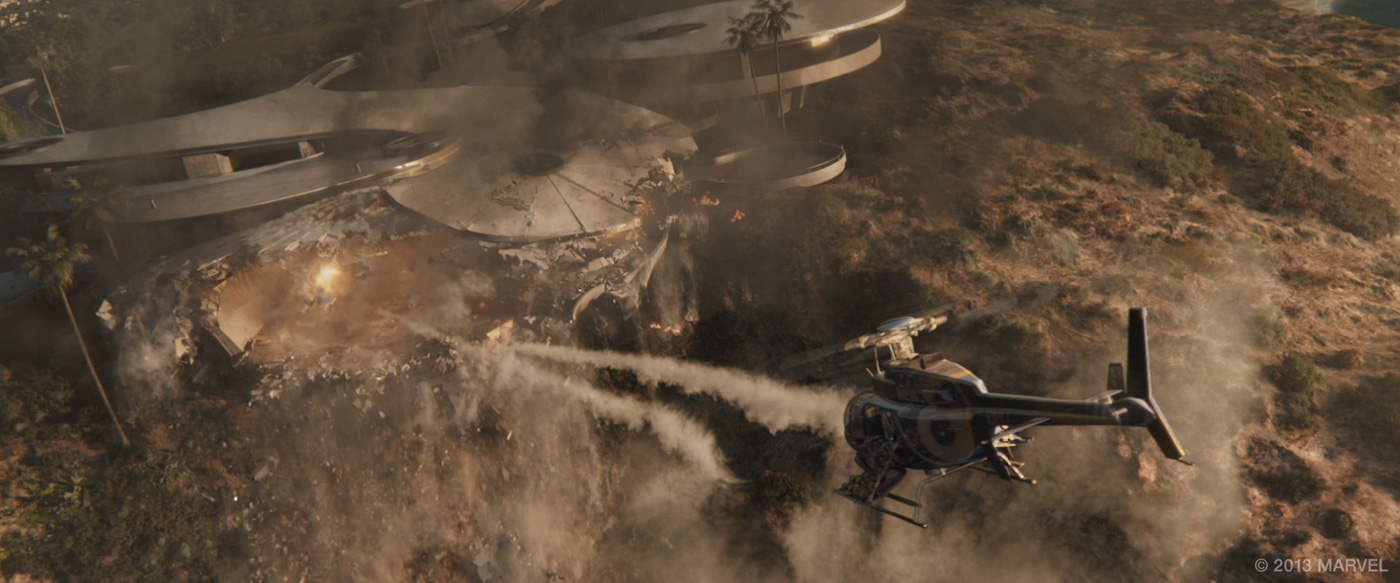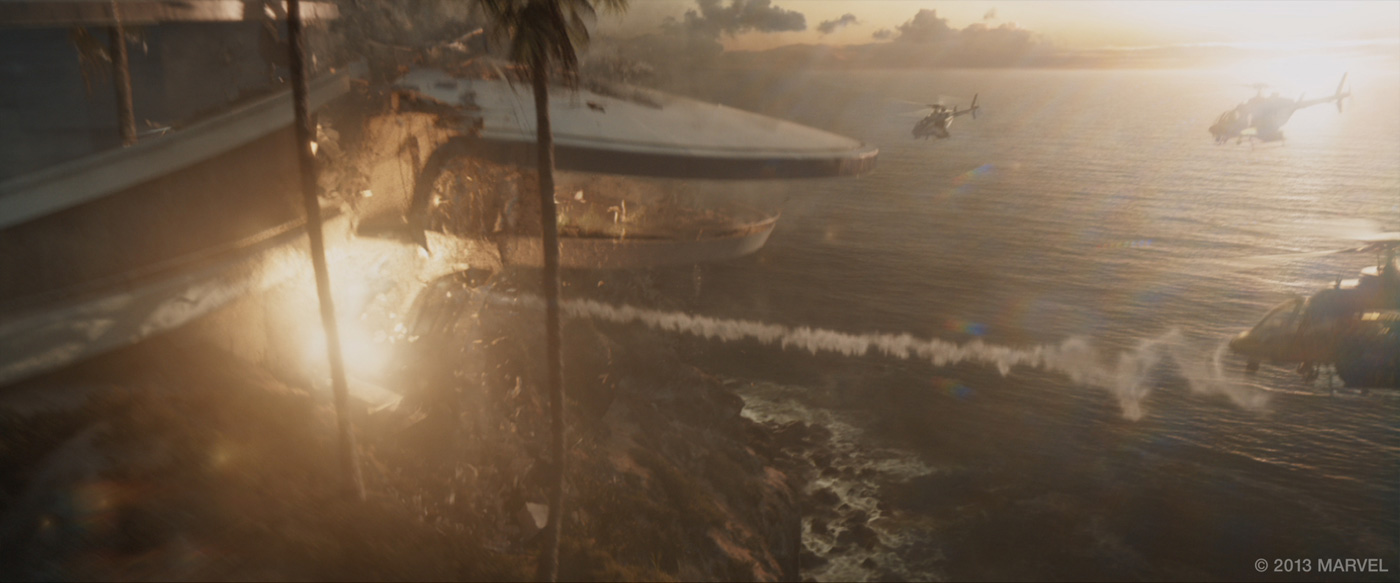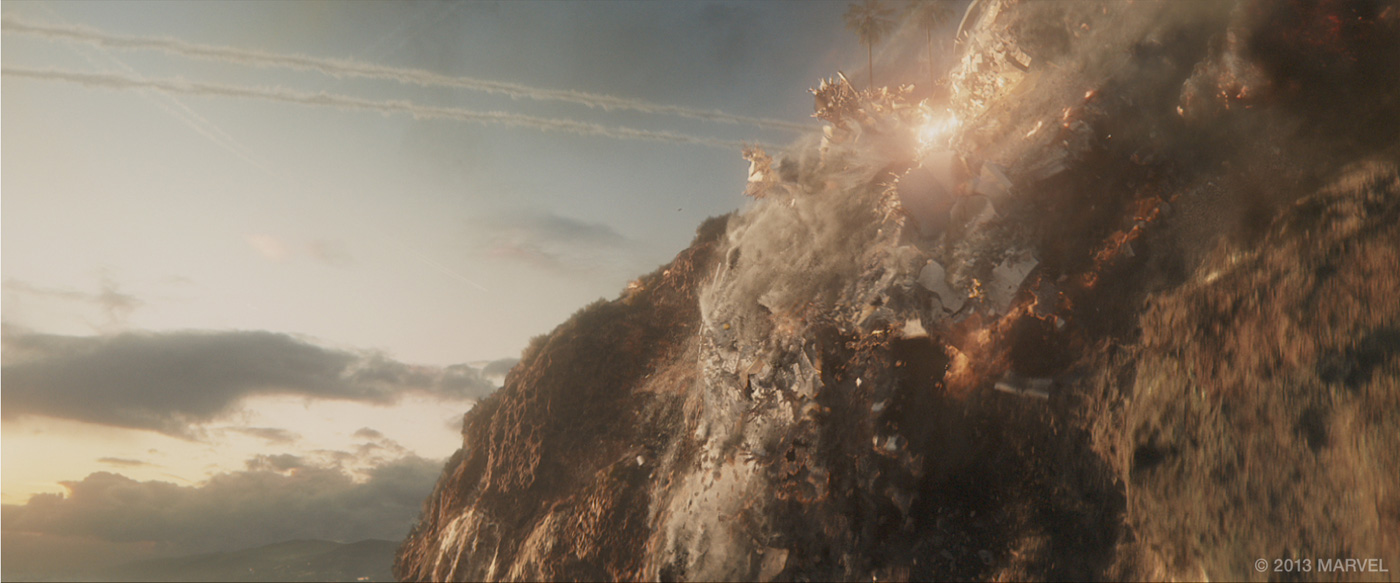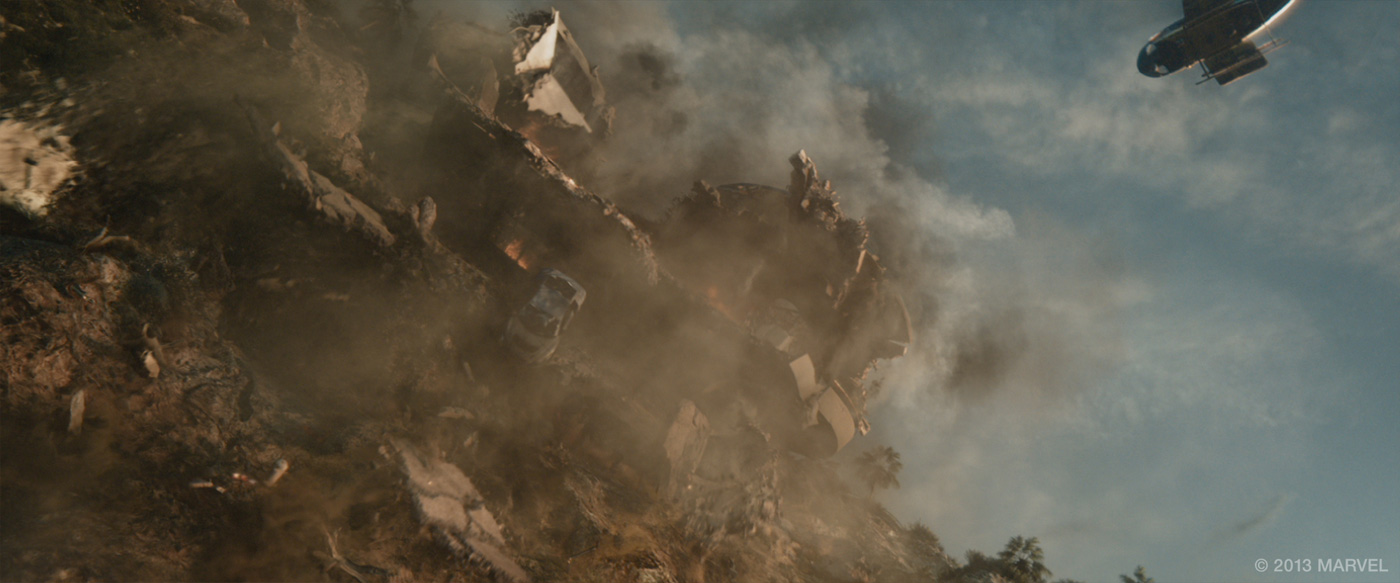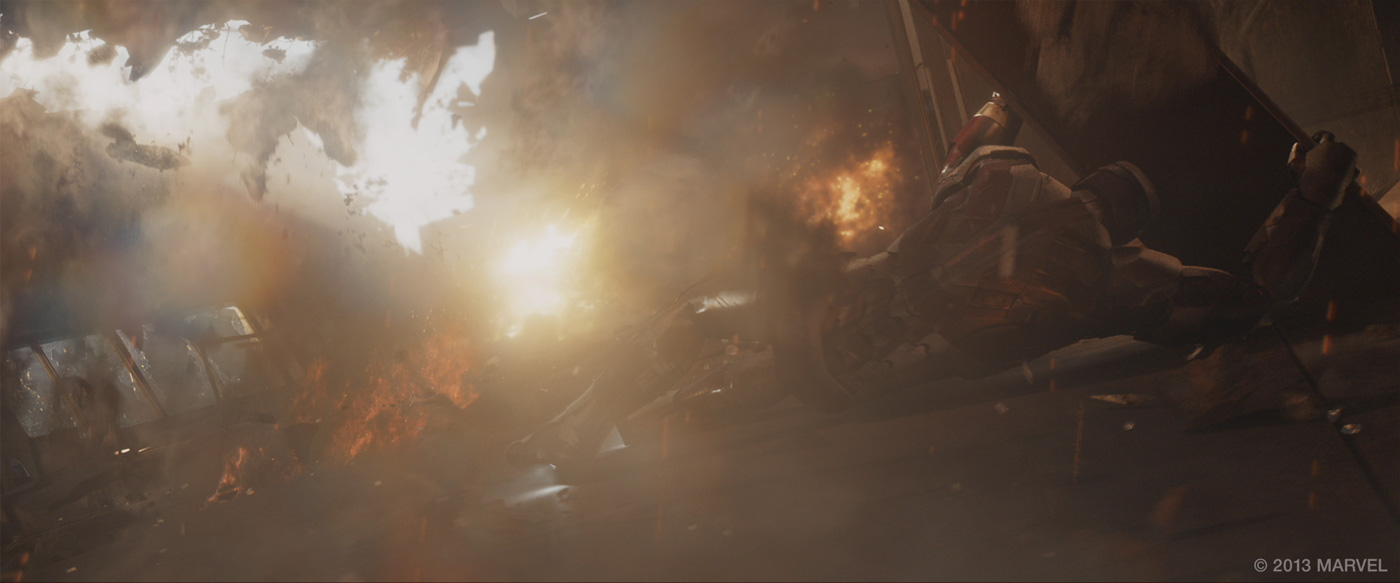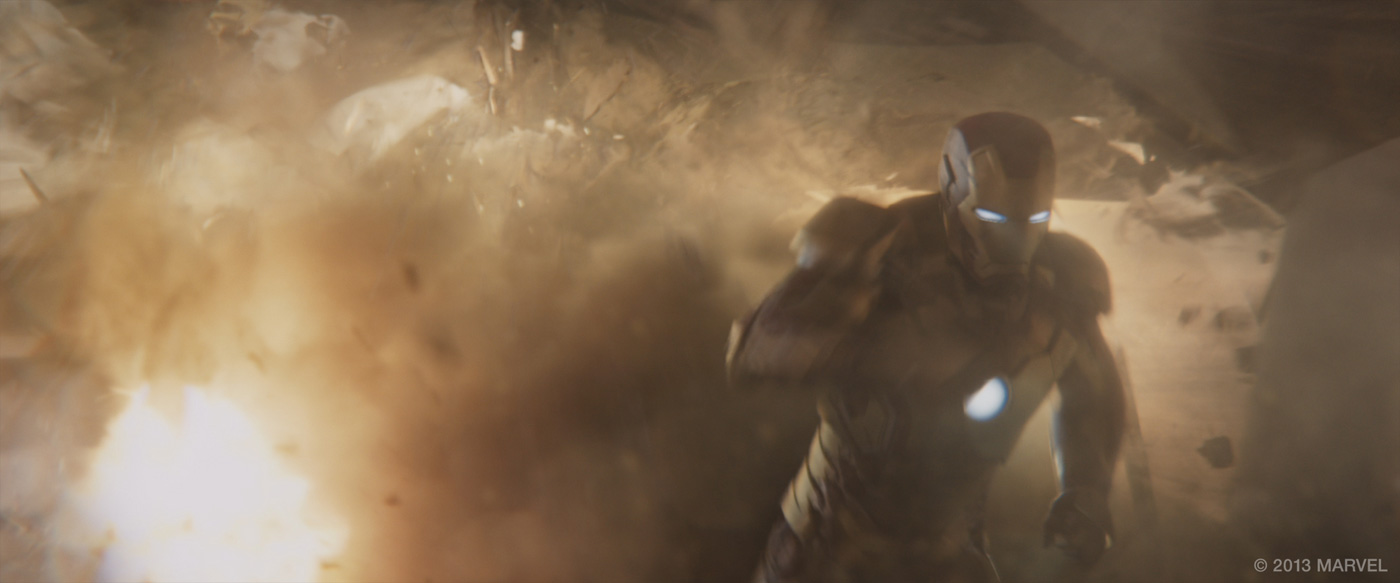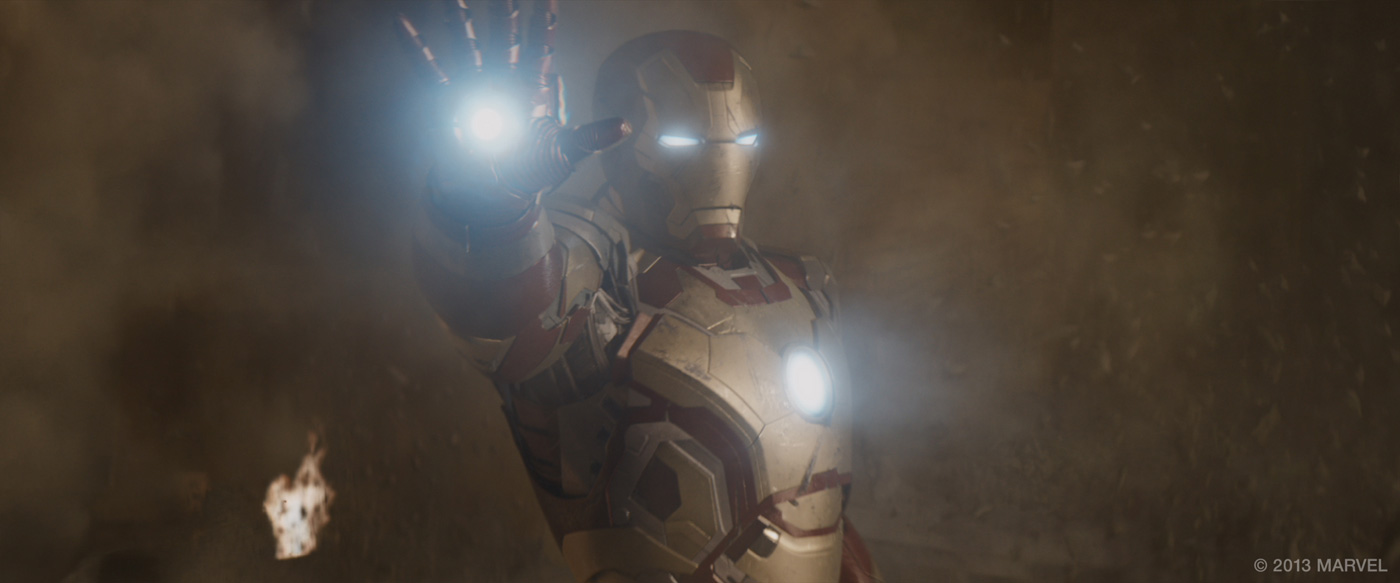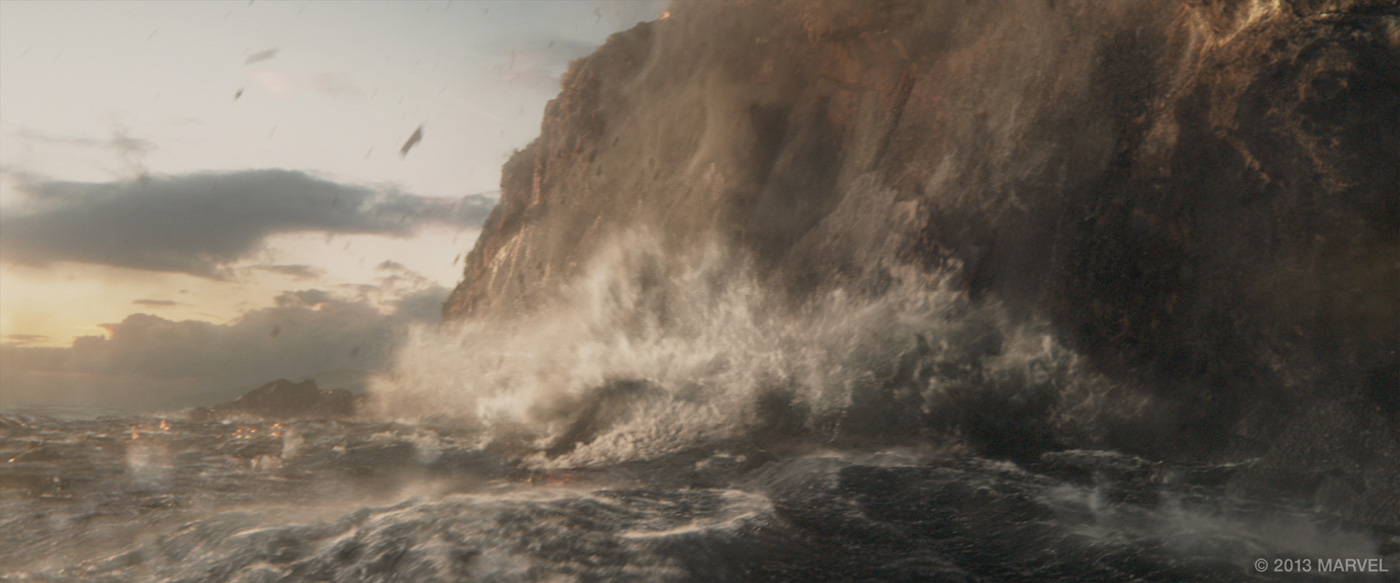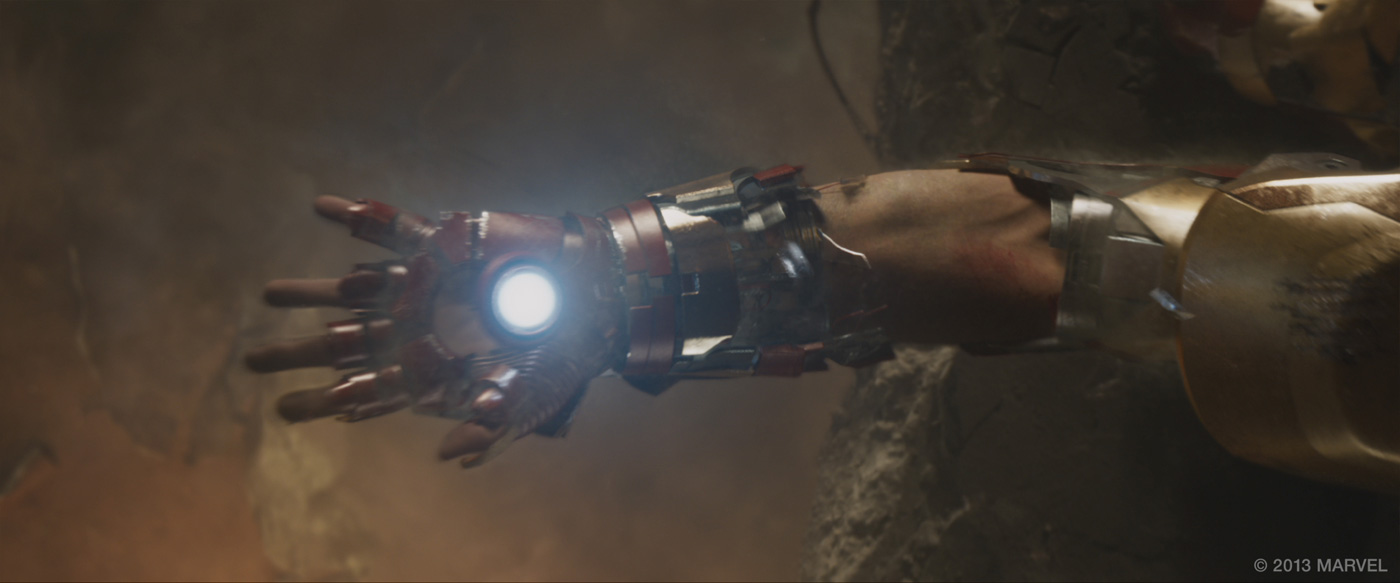During his last visit here, Bryan Grill had explained to us the work of Scanline VFX on HEREAFTER. He then worked on GULLIVER’S TRAVELS and THE AVENGERS.
How did Scanline VFX get involved on this show?
Scanline had previously worked on Marvel’s THE AVENGERS, and Victoria Alonso was a big fan our Helicarrier Take Off sequence for that film, which I supervised for Scanline. She was instrumental in getting VFX supervisor Chris Townsend and VFX producer Mark Soper to pay us a visit, tour the studio, and check out our latest work. Right from the start, they felt we were a good fit for the first big sequence in the film, the House Attack, and we were actually the first vendor on board.
How was the collaboration with director Shane Black?
The Director Shane Black and our team at Scanline didn’t really have much interaction. While on set shooting the house attack I had the pleasure of working with him and showing him some of our work. But after that everything went directly through Chris Townsend.
What was his approach with the visual effects?
Making everything look photoreal is very key for Chris. The main thing we needed to achieve on IM3 was a believable environment but it would need to be achieved through often fully synthetic cg visual effects. When Chris and his previs crew first started imagining the sequence they thought about how they would shoot this and the conclusion was that it would be very hard to shoot this sequence. So they made the decision to build the interior sets and everything else would be cg, but even the interior set — impressive as the breakaway tilting set was — required extensive digital work, whether it was added digital debris or various extensions getting destroyed, like when the floor gives way under Tony, blocking his escape.
Can you tell us more about your work with Production VFX Supervisor Christopher Townsend?
This was Scanline’s first collaboration with Chris, and at Scanline, we think it’s important to get inside the heads of our clients, so to speak, and understand their aesthetics. You need to try and see things through their eyes, and that can vary greatly from one person to the next. So we sat in the screening room at length and let him dissect some of our past work. In fact, we encouraged him to be critical. We wanted to know upfront, going in, what to expect. And to his credit, Chris was happy to oblige. His ability to communicate to us what he and what the filmmakers wanted to accomplish with the IM3 visual effects was very to the point. And the common theme was believability and realism.
What have you done on this show?
On IM3 Scanline was responsible for the House Attack sequence. This sequence include multiple environments, tapping into a wide range of disciplines and techniques.
There were 3 sets that were partially built: a driveway exterior, an interior living room which was built on a tilting gimbal by Special Effects supervisor Dan Sudick, and Tony’s basement garage set.
We built a digital version of the Point Dume environment and Tony’s mansion, as well as the CG water and background elements.
We modeled, textured and animated the Iron Man MK42 suit, both to augment and often replace the suit that was shot on set.
We rigged the digital mansion for destruction simulations, created CG smoke, fire and water; created the fleet of enemy helicopters, and created a digital underwater environment where Iron Man finds himself after the attack.
How did you collect all the necessary information on-set for your teams?
We collected data on set with a crew from Scanline in conjunction with the Production visual effects crew. All witness camera data for any character rotomation was supplied by the production. There was also LiDAR data that was being captured by 4DMax which always helps to recreate sets digitally. We also had a crew go out to Point Dume in Malibu to take photography of the surrounding area including a helicopter flight so we could take aerial pictures for textures and environment reconstruction.
The images themselves were also used to generate the basic textures which would be applied to the 3D model. We used Photogrammetry to calculate an accurate 3dimensional model of Point Dume from those photos. There was no surveying required at all. It was all based off of photographic imagery.
As shot design progressed, we found that we needed to continually get higher and higher resolution on the textures and model itself. Our shots required everything from a wide-angle, distant view to close up details around the base of the Mansion. In the end, the Point Dume cliff itself was composed of nearly 20 16k by 16k texture maps – just for the front cliff face. In order to get this level of detail, we organized several additional texture shoots. The more distant environment was created with reference photography and matte painting. The ocean around Point Dume was created in CG using our in-house water simulation software, Flowline. For the Mansion, we started with set schematics and designs from the Art Department at Marvel.
Because we were going to be destroying the Mansion in CG, we needed to start building the digital model long before the the live-action set was even built. Thus we had to be very careful to construct our CG model so that it would be adaptable to whatever they ultimately built on-set. We built the Mansion as a shell, with areas of much higher detail (including structural beams, concrete rebar,and internal supports) in these areas we expected to destroy later.
As more reference and photography came in from set, we refined the model and textures to match what they were building. We wouldn’t know until the shots were finally turned over, how much of the practical set would be kept and how much would be replace with CG.
How did you create the helicopters?
We started with a base Bell 407A model but we did extensive customization to give Chris and Marvel specific design features. That is a civil utility helicopter, and as you can imagine, it doesn’t typically come equipped with side mounted machine guns. As for nailing the lighting, it’s interesting that one of our best references came from Chris. He was on a helicopter shooting plates in Miami around that same time of day as our sequence takes place, and he snapped some photos on his iPhone 5. Which just goes to show you that sometimes you can find great ideas in the unlikeliest of places.
Can you explain in details about the impressive destruction of the house?
At the base, there were sections of the house (such as the living room) which were modeled and rigged in such a way that they could be animated by hand. We did this for most of the larger structures, for the moments such as where the supports give out and the living room section tilts forward.
The next level was fracturing the larger structures into smaller dynamic pieces using simulation software. These simulations were were then tweaked and art-directed as needed.
To add further detail, we used procedural techniques to generate additional edge breakup, modeling detail and rebar along the concrete pieces as they broke apart. The results of these simulations were then taken into our in-house simulation software, Flowline, to create trailing smoke and dust, and other volumetric effects. The final touch was to add 2D photographic elements into the mix, to add more texture and variation.
The sequence features many explosions. Can you tell us more about it?
The explosions were done generally in a similar fashion to the Mansion destruction. We would often start with a rigid body dynamic (RBD) simulation of exploding debris, and then use that as the basis for our Flowline simulations. Flowline has some very advanced capabilities concerning simulation of fire and smoke, and how the two integrate. Because the RBD-simulated geometry and the Flowline simulations exist within our lighting software, we were able to generate interactive lighting and reflections to help tie everything together. And then a bit of 2D photographic material mixed in for extra texture and complexity.
How did you created the Iron Man armor?
The Iron Man MK42 suit was designed by Marvel. We than took that cg suit and started to build on top of it. We did a first pass of the suit since we had been the first vendor on and than passed it too other vendors. There were different aspects of the suit that were specific to most sequences.
Can you tell us more about the impressive water simulations?
That is where our proprietary fluid sim software, Flowline, becomes a tremendous asset. Both for its versatility and its speed. The above water destruction required look dev that nailed scale, so that as the various debris piece hit the surface — some quite large, like the Audi or huge sections of the house — the scale is believable.
How did you improved your pipeline since THE AVENGERS?
Our biggest change was switching entirely from 3ds Max to Maya for animation, and given the extensive Iron Man animation, it was a rather smooth transition. We wrote an entire rigging pipeline for Maya that we’re continuing to use and refine for 300: RISE OF AN EMPIRE.
The sequence then goes underwater. Can you explain to us about the lighting challenge?
We started with underwater photography at different depths which showed us how much the light affected the water as we sunk deeper and deeper. We chose a depth of 200 feet below the cliff for our mansions final resting spot. The color palette was also very crucial it needed to feel like Southern California and not the turquoise of the Caribbean. The fall off of visibility was another challenge making sure we could see what was happening at all times buy using light and shadow to feature the objects we still needed to see.
How did you manage the render aspect of this sequence?
We dramatically increased the size of our render farm, since our 250 shots were running alongside the 600+ shots on 300: RISE OF AN EMPIRE, as well as other shows like A GOOD DAY TO DIE HARD and MAN OF STEEL. That increased firepower really helped us in that final push.
Have you worked on the super slow-motion shots during the first explosion?
The super slow motion shots during the first explosion required a lot of augmentation and clean up. We also had to replace the Pepper stunt double in one of the shots so that Pepper’s actions matched the following shots.
The hero shots of Pepper and Tony were shot on greenscreen with the phantom camera. It is these shots that we added all the interactive debris and smoke. This than led to the hero suit connect shot of Pepper being protected by the flying, attaching MK42 while she is blown back and engulfed in the explosion and debris.
What was the biggest challenge on this project and how did you achieve it?
The biggest challenge was making sure Marvel and Chris were happy. Marvel has an impressive track record, and they definitely set the bar pretty high. So you have to be prepared to deliver at a high level of realism and polish. Ultimately, the Scanline team succeeded. The proof is Victoria Alonso complimenting us and telling us we got to the 100% mark. Not 97% or 98%, where things looks great but there’s simply something not quite right. But 100%. That made us very proud.
Was there a shot or a sequence that prevented you from sleep?
Not really. As difficult as some of the shots were, I always felt that we knew exactly what we needed to do to get them across the finish line & that our great team had a handle on things.
What do you keep from this experience?
A reminder of just how lucky we are to be able to do what we do — this challenging, highly creative job. And an appreciation of how the artistry of visual effects are a huge aspect of how the biggest, most popular movies are made. And of course, I learned that anything can be done as long as you have the right motivation and the passion to see it through.
Which branches of Scanline VFX have worked on this show?
Three of ScanlineVFX branches worked on IM3: Los Angeles, Vancouver, and Munich.
How long have you worked on this film?
Scanline was first approached to work on IM3 in February of 2012 which gave us a full 13 months start to finish, including prep, shoot and post.
How many shots have you done?
Scanline ended up doing around 250 shot for IM3. 220 of those shots were for the house attack sequence.
What was the size of your team?
Between the 3 facilities we had about 125 people working on the show at our peak.
What is your next project?
I am once again working with Marvel, on CAPTAIN AMERICA: THE WINTER SOLDIER. We’re currently shooting and the film hits theaters April, 2014. Scanline is also working on DIVERGENT for Lionsgate, and THE WOLF OF WALL STREET, with Rob Legato and director Martin Scorsese.
There are a few other things in the works but we can’t talk about them just yet.
A big thanks for your time.
// IRON MAN 3 – VFX BREAKDOWN – SCANLINE VFX
// WANT TO KNOW MORE?
– Scanline VFX: Official website of Scanline VFX.
// IRON MAN 3 – SCANLINE VFX – CREDITS
|
VFX SUPERVISORS |
||
|
Bryan Grill |
||
|
Darren Poe |
Stephan Trojansky |
|
|
VFX CONSULTANT |
VFX PRODUCER |
ANIMATION SUPERVISOR |
|
Danielle Plantec |
Robert Evans |
Bernd Angerer |
|
CG SUPERVISORS |
||
|
Paul Ghezzo |
Justin Mitchell |
|
|
COMPOSITING SUPERVISOR |
||
|
Stefano Trivelli |
||
|
ASSOCIATE VFX PRODUCER |
EXECUTIVE PRODUCER |
|
|
Paul Kolsanoff |
Joel Mendias |
|
|
RIGGING SUPERVISOR |
PIPELINE SUPERVISOR |
MATCHMOVE SUPERVISOR |
|
Eric D. Legare |
Laszlo Sebo |
James Sweeney |
|
VFX LEADS |
||
|
Joe Scarr |
Greg Tsadilas |
Randall Ui |
|
Evan Fraser |
Jeff Kim |
Justin Mijal |
|
PRODUCTION MANAGEMENT |
||
|
Whitney Hagan |
Jasmin Hasel |
Nathaniel Holroyd |
|
Dave Kim |
Wendy Hulbert |
Scott Miller |
|
Bernardo Rodriguez |
Lisa K. Spence |
|
|
VFX CREW |
||
|
Gary Abrahamian |
Matt Adams |
Carlos Anguiano |
|
Katerina Arroyo |
Ed Bauman |
Jonathan Bird |
|
Derek Blume |
Markus Boos |
Tatjana Bozinovski |
|
Charlie Bradbury |
Baby Braulio |
Austin Brown |
|
Randy Brown |
Chad Buehler |
Francis Camacho |
|
Marco Capparelli |
Marco Checa Garcia |
Steve Cho |
|
Pascal Clausen |
Jessica Clifton |
Nick Crew |
|
Jimmy Cruz |
Richard Curts |
Nicholas Damico |
|
Christian Deiss |
Brian Dickett |
Yves D’Incau |
|
Kalene Dunsmoor |
Moritz Eiche |
Marijn Eken |
|
Arlend Engar |
Mathieson Facer |
Joseph Farrell |
|
Marvin Fonacier |
Thomas Ganshorn |
Anthony Han |
|
Josiah Howison |
Melissa Huerta |
Travis Wade Ivy |
|
Clint Jairam |
Abhishek Joshi |
Kimberly Julien |
|
Blaine Kennison |
Ji Woon Kim |
Joel Kittle |
|
Kelvin Ko |
Norman Kruesmann |
Andy Krupp |
|
Boon Yeo Kwen |
Charles Lai |
Julius Lechner |
|
Daniel Lee |
Lukas Lepicovsky |
Andrew Lesniak |
|
John Lindstein |
Christine Lo |
Alex Lombardi |
|
Michal Maciejewski |
Joseph Mangione |
Christopher McIlveen |
|
Mario Mercado |
Michael Miller |
Jonathan Mitchell |
|
Sergio Mucino |
Masakazu Murakami |
Adreas Nehls |
|
Vincent Papaix |
Goran Pavles |
Brian Peyatt |
|
Diego Piccinato |
Ben Pierre |
Oliver Pilarski |
|
Christian Pokorny |
Hannes Poser |
Ricardo Quintero |
|
Winston Quitasol |
Sandra Roach |
Shinichi Rembutsu |
|
Jon Reynolds |
Mark Richardson |
Saysana Rintharamy |
|
Amir Ronen |
Ramprasad Sampath |
Franz Schiller |
|
Ron Schrems |
Timo Schumacher |
Elaina Scott |
|
Jaeil Seo |
Martin Seu |
Keith A Sintay |
|
Sally Slade |
Brendan Smith |
Courteney Smith |
|
Jim Su |
Nils Thuerey |
Jean Frederic Veilleux |
|
Hristo Velev |
Toby Watson |
Blair Werschler |
|
Klaus Wuchta |
Tuba Yalcin |
Niki Yoblonski |
|
Kei Yoneoka |
Zach Zaubi |
|
© Vincent Frei – The Art of VFX – 2013

